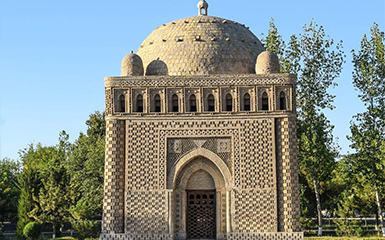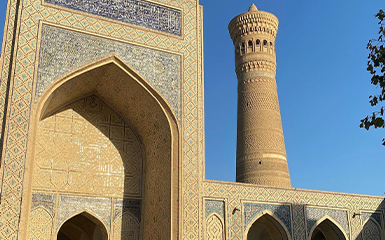Bahauddin complex
Char Minar
Lyab-I Hauz complex
Poi Kalan complex
The Ark Citadel
Bolo Haouz Mosque
Kalan Minaret
Islam Khodja complex
Itchan Kala
Kalta Minaret
Kunya Ark
Kutlugmurat Anak
Alla Kuli Khan
Muhammad Rahim Khan
Muhammed Emin Khan
Pahlawan Mahmud
Tash Hauli
Juma Mosque
Andijan
Muynak
Rabati Malik
The Kalan Minaret (Great Minaret) is a minaret in the Uzbek city of Bukhara. It is considered a symbol of the city.
The minaret stands in the middle of the historic centre of Bukhara in the Poi Kalan building ensemble, which is southeast of the Ark Citadel. It stands in the southeast corner of the square between the Kalan Mosque, to which it is connected by a bridge, and the Mir-Arab-Madrasa. To the east of the minaret is the Emir Alim Khan Madrasa.
The Kalan minaret was built in 1127 under the Karakhanid Arslan Khan, who was a vassal of the Sultan of the Seljuk Turks from 1102 to 1130. Genghis Khan is said to have been so impressed by the building that he had it spared when Bukhara was destroyed. During the conquest of Bukhara by the Bolsheviks in 1920, the minaret was slightly damaged by warning shots.
In addition to its function as a minaret, from which first a muezzin, and later several, called the Muslims to prayer, the tower also fulfilled other tasks. On the one hand it served as a watchtower and on the other hand it was a sign that was visible from afar and showed the caravans the way into the city. Until the early 20th century, it also served as a place of execution, from which those condemned to death were thrown down in a sack.
The minaret is an approximately 50 meter high, tapering tower with a base diameter of more than 10 meters. At its upper end it widens into a rotunda, which is decorated like stalactites and contains a circumferential gallery with 16 pointed arched windows. Above this rotunda sits a conical tip.
The tower is built as a brick shell. As with the Samanid mausoleum, the bands surrounding the tower are provided with different patterns through different arrangements of the bricks. In the lower part, a band of writing runs around the tower, and directly below the stalactite-like decorated rotunda runs a band of blue-green glazed bricks and forms a contrast to the natural ochre of the fired bricks. It is the oldest known example of the use of paint as an additional decorative element to the arrangement of the bricks.


